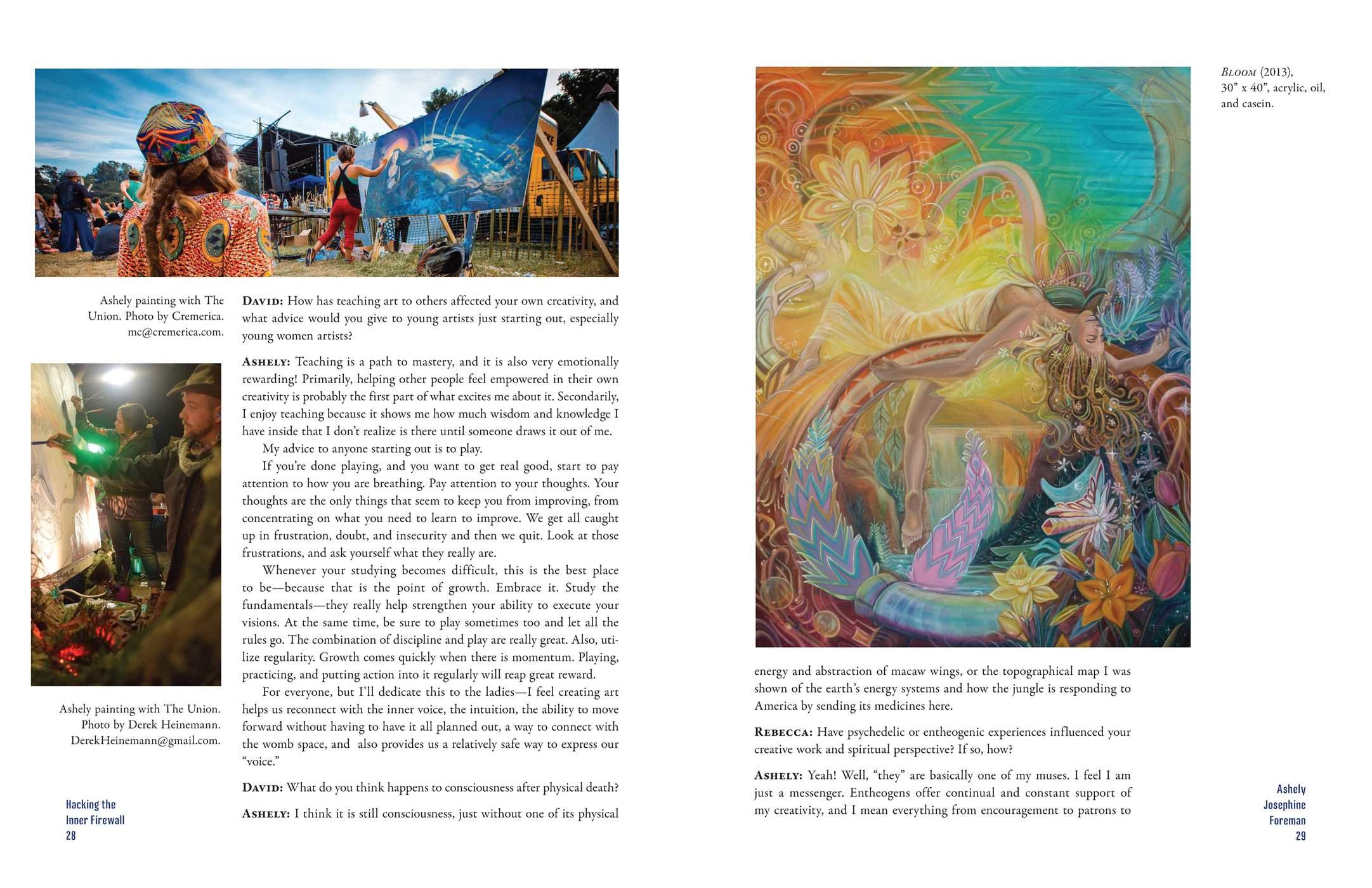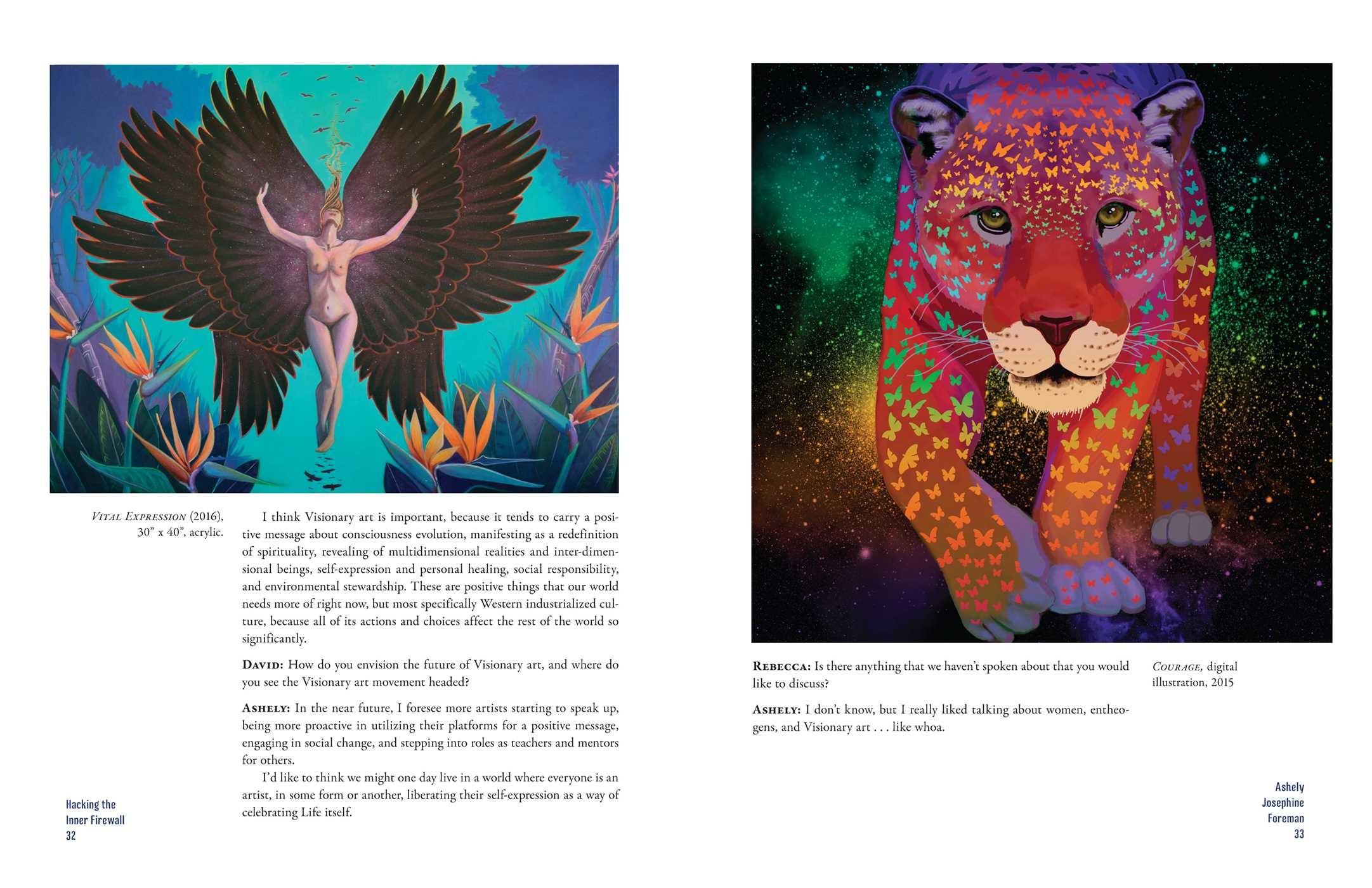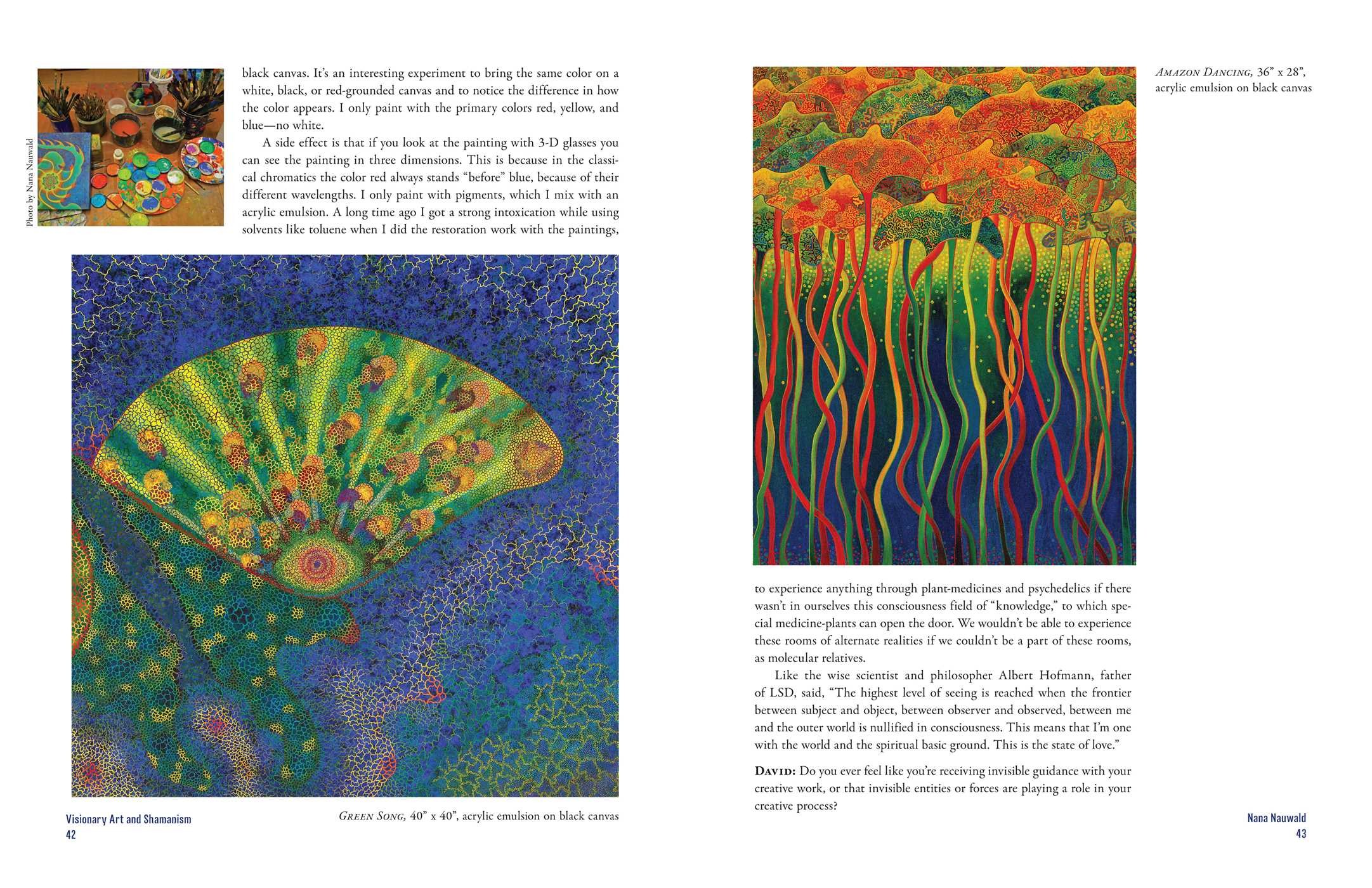Plus get our latest book recommendations, author news, and competitions right to your inbox.
Women of Visionary Art
Table of Contents
About The Book
• Includes discussions with 18 well-known female artists, including Josephine Wall, Allyson Grey, Amanda Sage, Martina Hoffmann, Penny Slinger, and Carolyn Mary Kleefeld
• Reveals how they have all been inspired by deep inner experiences and seek to express non-ordinary visions of reality, reminiscent of shamanic trance states, lucid dreams, and spiritually transcendent experiences
• Shows how visionary art often contains an abundance of feminine energy, helping us to heal ourselves and see that we are all connected
Since early humans first painted from their mystic eye onto cave walls, artists have sought to share their sacred visions with the world. Created in every medium, from oil painting and sculpture to contemporary digital modeling, these visionary works of art give those who experience them a chance to “see the unseen,” realize wider modes of perception, and discover spiritual and mystical realms.
In this full-color illustrated book, David Jay Brown and Rebecca Ann Hill examine the work and inspirations of eighteen of today’s leading female visionary artists, including Josephine Wall, Allyson Grey, Amanda Sage, Martina Hoffmann, Penny Slinger, and Carolyn Mary Kleefeld. They explore the creative process and the role that dreaming, psychedelic experiences, sexuality, and divine guidance play in the work of these women, alongside full-color examples of their art. They discuss the future of visionary art and reveal how these artists have all been informed and inspired by deep inner experiences and seek to express non-ordinary visions of reality, often reminiscent of those encountered in shamanic trance, lucid dreams, psychedelic states, spiritually transcendent experiences, and other altered states.
Showing how visionary art often contains an abundance of feminine energy, helping us to heal ourselves and see that we are all connected, the authors explore with each artist what it is about being a woman that has most influenced their artwork. They also examine the connection between visionary art and spirituality, the influence of Nature and sacred geometry, and how this creative form is simultaneously ancient, futuristic, and timeless, providing an accessible doorway into the visionary realm.
Excerpt
One of the biggest criticisms that I’ve received about my previous interview books is that the men I conversed with disproportionately outnumber the women. While I have always maintained that gender had nothing to do with how I chose my subjects, the male-to-female imbalances continued--as did the criticisms--so I have long wanted to do a collection that was composed exclusively of interviews with brilliant and remarkable women. That was part of the inspiration for doing this book.
Another inspirational source came from my previous use of psychedelic sacraments--like LSD, cannabis, psilocybin (“magic”) mushrooms, DMT, and ayahuasca. Among the many mysterious effects that psychedelic substances have on the human mind, their powerful enhancement of sensory perception and the creative imagination is intrinsically intriguing. I have long loved visual art that attempts to capture the astonishing visions and extraordinary eidetic imagery that one sees while under the influence of hallucinogens.
A third inspirational force arose from the partnership with my wife, Visionary artist Rebecca Ann Hill. Many of the questions that we asked the talented artists in this book came from epic, late-night discussions that Rebecca and I had about the complex nature of creativity, the mystery of artistic genius, the challenge in capturing the details of a psychedelic vision, and the discovery of unexplored artistic possibilities.
The Lost Language of Unseen Worlds
An Interview with Allyson Grey
Allyson Grey is a Visionary and performance artist, whose primary mediums are painting, live painting, and “social sculpting.”
Allyson’s beautiful paintings express colorful patterns of sacred geometry. These geometrical, sometimes symmetrical, mosaic-like arrangements of colored panels and mysterious alien language characters are uniquely gorgeous. They have unusual mind-altering properties that can induce powerful trance states.
Rebecca: Your artwork is so vibrant in color; I’m most curious about how you achieve the unique effects that you do. Can you share some of your artistic secrets, like what specific types of paints and tools you use when you work?
Allyson: Watercolors, acrylic painting, and oil paintings comprise my three separate bodies of painting. For two years I committed my painting to ink wash.
David: How would you describe your creative process?
Allyson: My creative process is my life. A perfect day and most days include practicing piano, creative writing, painting, and developing CoSM, our social sculpture. When I look I cannot find anything in my life that is not creative. Taking a bath can be creative. Process means having a plan. I have a plan for my bath.
Hacking the Inner Firewall
An Interview with Ashely Josephine Foreman
Ashely Josephine Foreman is an accomplished artist based in Northern California. Her work has appeared in galleries, community spaces, coffee shops, and at numerous transformational art and music festivals. Ashely collaborates extensively with other artists, including large-scale murals with The Union & Phaneros Gallery. Beyond the canvas, she works in digital illustration, teaching, and tattooing, and her work can be found on clothing and other licensed materials.
David: How has teaching art to others affected your own creativity, and what advice would you give to young artists just starting out, especially women artists?
Ashely: Teaching is a path to mastery, and it is also very emotionally rewarding! Primarily, helping other people feel empowered in their own creativity is probably the first part of what excites me about it. Secondarily, I enjoy teaching because it shows me how much wisdom and knowledge I have inside that I don’t realize is there until someone draws it out of me.
My advice to anyone starting out is to play.
If you’re done playing, and you want to get real good, start to pay attention to how you are breathing. Pay attention to your thoughts. Your thoughts are the only things that seem to keep you from improving, from concentrating on what you need to learn. We get all caught up in frustration, doubt, and insecurity, and then we quit. Look at those frustrations, and ask yourself what they really are.
Whenever your studying becomes difficult, this is the best place to be--because that is the point of growth. Embrace it. Study the fundamentals--they really help strengthen your ability to execute your visions. At the same time, be sure to play and let all the rules go. The combination of discipline and play are really great. Growth comes quickly when there is momentum. Playing, practicing, and putting action into your art regularly will reap great rewards.
Visionary Art and Shamanism
An Interview with Nana Nauwald
Nana Nauwald is an internationally recognized Visual artist and worldwide expert on shamanism who lives in Germany. For more than twenty years she has studied different forms of shamanism, particularly in the Peruvian Amazon and Nepal as well as in Europe and Siberia. Nauwald has also researched and practiced ritual body postures and is the author of twelve books about shamanism.
David: How did you first become interested in the interface between shamanism and creative expression?
Nana: I grew up in a world that was signified through art and experiences in nature and imbedded in a world of fairy tales. Fairy tales and myths have been the companions of my childhood; so it was always natural for me to notice that there is an unseen life behind every appearance in nature. These unseen worlds expressed themselves easily for me to “see” in sparkling, changing colors, and forms.
I first came in contact with the expression “shamanism”--as the interface of art and the spirit of nature, the spirit of life when I studied art.
Today, after more than thirty years of exploring and experiencing fields of shamanic consciousness, after finding more and more ways of making this field visible, these two areas for humanity are “one” inside of me.
Product Details
- Publisher: Park Street Press (November 13, 2018)
- Length: 384 pages
- ISBN13: 9781620556931
Browse Related Books
Raves and Reviews
“This book literally bursts out at you. The art, ideas, and personality of each contemporary Visionary female artist shine forth and illuminate a vital but underappreciated world of creativity.”
– Rick Strassman, M.D., author of DMT: The Spirit Molecule
“The moral force of the divine feminine is awakening humanity to higher conscience and higher consciousness, through visions now appearing in the work of the psychedelic sisters of Visionary art.”
– Alex Grey, Visionary artist and author of Sacred Mirrors
“I love this book. From David Jay Brown’s remarkable positioning essay to the last image, it is a delicious introduction to the lives of and sensual vibrant transcendent images by a collection of women, any chapter of which would make the book worth owning. Often, it was difficult to stay with the interviews, because the interspersed images kept lifting me away from the prose. The interviews go so much deeper than the usual description of art and artist, including the struggles, the pain, the overcoming of traditional training, and these artists’ surprising insights into creation itself. For many of the women, their art was life-saving; for all of them, it is intensely lifeaffirming. This is a book to read and enjoy; it is a book to cherish.”
– James Fadiman, Ph.D., microdose researcher and author of The Psychedelic Explorer’s Guide
“Women of Visionary Art is a goldmine of human potentiality and transpersonal states of consciousness expressed through the interface of being a woman. David Jay Brown and Rebecca Ann Hill have crafted questions that bring up essential aspects of each artist’s vision and philosophy. Their interview questions are like lures reaching into the depths and consistently bring up a kaleidoscopic variety of profound nuggets of numinous experience and handcrafted wisdom. Insights into Visionary artistry as spiritual practice and career path come to the surface. If you are interested in sexuality and mysticism, creative process and methods of inspiration, in navigating the dreamtime and imagining the divine, you will definitely want to read this book and behold the stunning artwork of these masters of the craft. The book itself is a masterpiece of word and image.”
– C. Michael Smith, Ph.D., author of Jung and Shamanism in Dialogue
“We live in times where spiritual art is extremely important in the awakening of humanity. Women have a kind of female sensitivity that is very special in that equation, and thus they have a very important role in the communication this spiritual art has to offer. In Women of Visionary Art we get to learn about the wonderful magical female creators who brought forth these special visions of personal and cultural enlightenment.”
– Chris Dyer, Visionary artist
"Women of Visionary Art is an impressive 8.5x 11 inches, full-color art-piece packed with illustrations of some of the most talented, visionary women artists of today. This array of women artists truly makes you feel that you are part of something larger - a step forward perhaps, where artistic expression and spiritual vision are right there in front of your eyes to be enjoyed."
– Sofia Karin Axelsson, publisher of The Echo World newspaper
"The interviews read as if you are invited to participate in a conversation among equals. Each chapter is packed with full-color images to fall into. The book ends with a list of recommended reading and a bibliography that's well done and an index. The artists share their techniques, inspirations, and setbacks along with years of accumulated wisdom. This is no mere coffee table book, but a vital link in the chain of women’s wisdom."
– Lisa Mc Sherry, Facing North
Resources and Downloads
High Resolution Images
- Book Cover Image (jpg): Women of Visionary Art Hardcover 9781620556931
























